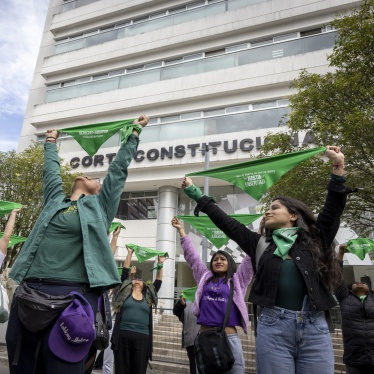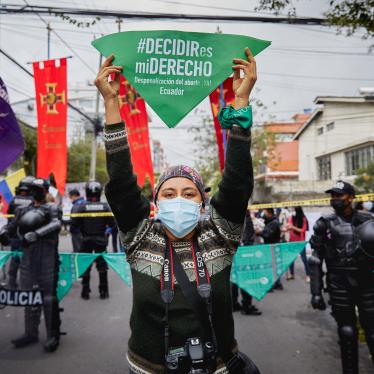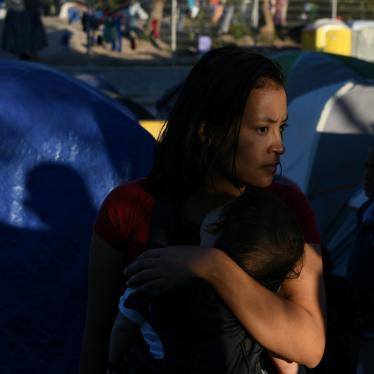The National Confederation of Rural Women (Confederación Nacional de Mujeres del Campo or CONAMUCA), Network of United Youth Voices (Red Juvenil Voces Unidas), the Coalition for Women’s Life and Dignity (Coalición por la Vida y la Dignidad de las mujeres), and Human Rights Watch write in advance of the 94th session of the Committee on the Rights of the Child (the “Committee”) and its review of the Dominican Republic. This submission addresses articles 3, 6, 24, 28, and 29 of the Convention on the Rights of the Child and covers access to abortion and specific aspects of the right to education.
Access to Abortion and Teenage Pregnancy (articles 3, 6, 24, and 29)
The total abortion ban in the Dominican Republic, in effect since 1884, threatens the health and lives of girls, women, and pregnant people, and is incompatible with the country’s international human rights obligations.
Abortion is illegal in the Dominican Republic even when a pregnancy is life-threatening, unviable, or the result of sexual violence or incest. The criminal code in the Dominican Republic penalizes girls, women, and pregnant people who induce abortions and anyone who assists them.[1] Under article 317 of the criminal code, doctors, surgeons, midwives, nurses, pharmacists, and “other medical professionals” who provide abortions face prison terms of five to 20 years.[2] Pregnant girls, women, or people who induce or consent to abortions, and any individuals who relay information to pregnant people about obtaining an abortion, if the abortion occurs, face six months to two years in prison.[3]
The harmful consequences of the Dominican Republic’s abortion ban have been documented through interviews with dozens of women and girls who faced unwanted pregnancies and turned to unsafe abortion methods, often at great risk to their health and lives.[4] The country’s abortion ban has contributed to preventable health complications and maternal deaths and has disproportionately harmed women and girls from low-income and rural areas, who are less likely to be able to access safer abortion methods or travel to another country where abortion is legal.[5]
Globally, unsafe abortion contributes to preventable maternal deaths. In 2020, the maternal mortality ratio in the Dominican Republic stood at 107 per 100,000 live births, surpassing that of the Latin American region, which was 88 maternal deaths per 100,000 live births.[6]
In interviews conducted by nongovernmental organizations, girls and women of reproductive age who had had unplanned or unwanted pregnancies cited a variety of reasons for such pregnancies, including barriers to accessing contraceptive methods, contraceptive failures, and sexual violence.[7]
The Dominican Republic has been in the process of reforming its penal code for years, with abortion being a major issue of debate. Women’s rights groups have urged lawmakers to decriminalize abortion when the life of the girl, woman, or pregnant person is in danger, when the pregnancy resulted from sexual violence or incest, and when the fetus has serious complications incompatible with life outside of the womb. President Luis Abinader has also expressed support for the initiative.[8]
But the Dominican Republic’s Chamber of Deputies approved in June 2021 a last-minute modification of the draft of the Penal Code that did not include the decriminalization of abortion under the three limited circumstances.[9] In February 2023, that draft was further approved by the Senate.[10] However, it expired in July 2023, so a new one must be reintroduced and the process in the Chamber of Deputies must be initiated so that it can return to the Senate.
Research shows that restrictive laws and criminal penalties do not reduce the incidence of abortion.[11] Authoritative interpretations of international human rights law establish that denying women, girls, and pregnant people access to abortion is a form of discrimination and jeopardizes a range of human rights, including the rights to life; health; freedom from cruel, inhuman, and degrading treatment; nondiscrimination and equality; privacy; information; and freedom to decide the number and spacing of children. For instance, this Committee has noted that “the risk of death and disease during the adolescent years is real, including from preventable causes such as … unsafe abortions” and urged states to “decriminalize abortion to ensure that girls have access to safe abortion and post-abortion services, review legislation with a view to guaranteeing the best interests of pregnant adolescents and ensure that their views are always heard and respected in abortion-related decisions.”[12]
According to the Pan-American Health Organization (PAHO), the adolescent fertility rate in the Dominican Republic is significantly higher than the regional average for Latin America and the Caribbean.[13] The government registered 25,461 pregnancies among adolescents ages 10 to 19 in 2022.[14] Nearly 20 percent of births, abortions, and miscarriages attended in public health centers in 2022 were among adolescents under age 19, according to government data.[15]
Adolescent pregnancy and early childbearing carry significant health risks for both the mother and the child. Girls and young women ages 10 to 19 are at elevated risk for a number of serious health conditions associated with pregnancy and childbirth.[16] Babies born to adolescent mothers are at higher risk of low birthweight, preterm delivery, and severe neonatal conditions.[17]
According to 2019 data, adolescents living on lower incomes disproportionately experience teenage pregnancies. The fertility rate among adolescents ages 15 to 19 in the lowest-income quintile in the country is more than five times higher than the adolescent fertility rate for the highest-income quintile.[18]
An estimated 44 percent of school dropouts in the Dominican Republic are a consequence of teenage pregnancy,[19] limiting adolescents’ professional development and later their employment, increasing the social gap and continuing the cycle of poverty.
Despite legal protections barring schools from sanctioning or removing students due to adolescent pregnancy, research by Human Rights Watch and other nongovernmental organizations suggests pregnant adolescent girls and young mothers in the Dominican Republic encounter barriers to education.[20]
Human Rights Watch encourages the Committee to ask the government of the Dominican Republic:
- What steps is the government taking to reduce the maternal mortality rate in the Dominican Republic and to avoid preventable maternal deaths from unsafe abortion?
- What steps is the government taking to provide girls, women, and pregnant people with information on the safety and risk of different measures used to induce abortion?
- What steps is the government taking to train healthcare providers in caring for patients facing unintended or unwanted pregnancies, presenting with incomplete abortions, or seeking post-abortion care?
- What steps is the government taking to provide comprehensive sexuality education to all children and adolescents, in line with international standards and recommendations?
- What steps is the government taking to reduce the adolescent pregnancy rate and ensure pregnant students and young parents are supported in continuing their education?
Human Rights Watch encourages the Committee to call on the government of the Dominican Republic to:
- Decriminalize abortion as a matter of urgency by removing all criminal penalties for abortion from the penal code.
- At a minimum, reform the penal code to provide women, girls, and pregnant people with access to safe and legal abortion services when the pregnancy poses a risk to the life or health of the woman or girl or pregnant person, when the fetus has a serious condition incompatible with life outside the womb, or when the pregnancy resulted from any form of sexual violence.
- Conduct research on the sexual and reproductive health needs of women and adolescent girls, to identify factors contributing to unintended and early pregnancies. Investigate barriers in access to, and consistent use of, the contraceptive methods provided by the National Health System. Modify national health policies as needed to expand contraceptive options and address these barriers.
- Ensure health centers do not stigmatize adolescents who are sexually active, and that they are staffed with medical personnel qualified to provide confidential and comprehensive adolescent health services.
- Implement public information and awareness-raising campaigns that address the stigma around adolescent sexuality and promote healthy adolescent sexual practices. Ensure such campaigns make clear that adolescent children do not need an adult’s authorization to access sexual and reproductive health information and services.
- Ensure that epidemiological reports on maternal deaths issued by the government include the age of the victim in order to improve records and design better public policies for prevention.
- Strengthen services for women and girls facing sexual violence, domestic violence, and other forms of abuse. Ensure links between services for survivors of violence and medical providers, so that survivors of abuse can easily access specialized medical care. Ensure that medical providers consistently refer patients they know, or suspect, are experiencing abuse to comprehensive, supportive services.
- Implement a mandatory comprehensive sexuality education curriculum in primary and secondary schools that complies with international standards and is scientifically accurate, rights-based, and age-appropriate. Ensure the curriculum reaches students from an early age and builds incrementally to equip them with developmentally relevant information about their health and wellbeing. As part of the curriculum, provide children with practical information about how to use contraceptive methods and where they can obtain contraceptive supplies, as well as information on sexually transmitted diseases.
Right to Education (article 28)
Support for strengthening the explicit right to free education in international law
In June 2023, the Dominican Republic co-led with Luxembourg a statement delivered during the interactive dialogue with the Special Rapporteur on the right to education at the UN Human Rights Council. Joined by 71 other countries, the statement expressed support for “efforts to strengthen the right to education, including the explicit right to full free secondary and at least one year of free pre-primary education.”[21]
Human Rights Watch encourages the Committee to:
- Welcome the Dominican Republic’s spirit of international cooperation in support of strengthening the right to education, including an explicit right to full free secondary education for all children and at least one year of free pre-primary education, with the same priority and urgency as the right to free primary education.
Protection of education from attack
The Safe Schools Declaration[22] is an inter-governmental political commitment that provides countries the opportunity to express political support for the protection of students, teachers, and schools during times of armed conflict; the importance of the continuation of education during armed conflict; and the implementation of the Guidelines for Protecting Schools and Universities from Military Use during Armed Conflict. [23] The Dominican Republic endorsed the declaration in December 2017. [24]
Human Rights Watch encourages the Committee to:
- Congratulate the Dominican Republic for endorsing the Safe Schools Declaration.
- Ask the Dominican Republic whether protections for schools from military use are included in any policies, rules, or trainings for its armed forces.
- Recommend that the government incorporate the declaration’s standards in domestic policy, military operational frameworks, and legislation, and share any good practices with other regional countries.
- Recommend that the government take all necessary steps to provide comprehensive sexuality education.
[1] Penal Code of the Dominican Republic, 1884, art. 317, modified by laws 1690 of April 8, 1948, 224 of June 26, 1984, and 46-99 of May 20, 1999. “Who, by means of food, concoctions, medicines, probes, treatments or in any other way, causes or directly cooperates in causing the abortion of a pregnant woman, even if she consents to it, shall be punished with a minor imprisonment.”
[2] Ibid., art. 317. “Physicians, surgeons, midwives, nurses, pharmacists, and other medical professionals who, abusing their profession, cause an abortion or assist in it, shall incur a penalty of five to twenty years of imprisonment, if the abortion is carried out.”
[3] Ibid., art. 317. “A prison sentence of six months to two years shall be imposed on individuals who have facilitated a pregnant woman’s connection or communication with another person in order to induce abortion, provided that the abortion has been carried out, even if they did not directly participate in the abortion.” “The same penalty shall be imposed on a woman who causes an abortion or who consents to the use of substances indicated or administered to her for that purpose, or submits to abortion-inducing methods, provided that the abortion has been carried out."
[4] Human Rights Watch, “It’s Your Decision, It’s Your Life”: The Total Criminalization of Abortion in the Dominican Republic (New York: Human Rights Watch, 2018), https://www.hrw.org/report/2018/11/19/its-your-decision-its-your-life/total-criminalization-abortion-dominican-republic; “Dominican Republic: What happens when abortion is totally banned?”, November 19, 2018, video clip, YouTube, https://www.youtube.com/watch?v=nyAaHB2VyM8.
[5] Ibid.
[6] United Nations Population Fund (UNFPA) República Dominicana, “46% of Dominican women do not have access to contraceptives, and 23% are unable to make decisions about their sexual and reproductive health, according to a report by UNFPA,” April 24, 2023, https://dominicanrepublic.unfpa.org/es/news/46-mujeres-dominicanas-no-accede-anticonceptivos-y-23-no-puede-tomar-decisiones-sobre-su-salud (accessed August 2, 2023).
[7] Human Rights Watch, “It’s Your Decision, It’s Your Life.”
[8] See, for example, Nicole Acevedo, “The fight against Dominican Republic’s total abortion ban intensifies after polarizing decision,” NBC News, April 14, 2021, https://www.nbcnews.com/news/latino/fight-against-dominican-republic-s-total-abortion-ban-intensifies-after-n1263978 (accessed August 1, 2023); and Amnesty International, “Dominican Republic: Threat to sexual and reproductive rights,” September 24, 2021, https://www.amnesty.org/en/documents/amr27/4778/2021/en/ (accessed August 1, 2023).
[9] “Dominican Republic: Chamber of Deputies puts life and health of millions of women and girls at risk,” Amnesty International press release, June 30, 2021, https://www.amnesty.org/en/latest/press-release/2021/06/republica-dominicana-camara-de-diputados-pone-en-riesgo-la-vida-y-salud-de-millones-de-mujeres-y-ninas/ (accessed August 1, 2023).
[10] Noor Mahtani, “Nuevas leyes, mismo olvido: el Código Penal de República Dominicana ignora el derecho al aborto,” El País, February 12, 2023, https://elpais.com/opinion/2023-02-12/nuevas-leyes-mismo-olvido-el-codigo-penal-de-republica-dominicana-ignora-el-derecho-al-aborto.html (accessed August 2, 2023); Senate of the Dominican Republic, “Aprueban en segunda lectura Código Penal; establece nuevos tipos penales,” February 14, 2023, https://www.senadord.gob.do/aprueban-en-segunda-lectura-codigo-penal-establece-nuevos-tipos-penales/ (accessed August 2, 2023).
[11] Susheela Singh et al., Abortion Worldwide 2017: Uneven Progress and Unequal Access, Guttmacher Institute, 2018, https://www.guttmacher.org/report/abortion-worldwide-2017 (accessed August 1, 2023).
[12] UN Committee on the Rights of the Child, General Comment No. 20 on the implementation of the rights of the child during adolescence, UN Doc. CRC/C/GC/20 (2016), paras. 13 and 60.
[13] The adolescent fertility rate, defined as the number of pregnancies per 1,000 girls and young women ages 15 to 19, was 63.2 in the Dominican Republic in 2022, compared to 37.7 for the region. Pan American Health Organization (PAHO), Core Indicators Dashboard, Adolescent Fertility Rate (Births/1,000 women aged 15-19), 2022, https://opendata.paho.org/en/core-indicators/core-indicators-dashboard (accessed August 14, 2023).
[14] National Statistics Office (Oficina Nacional de Estadística): Data on Pregnant Girls and Adolescents Treated in Hospitals, Dominican Republic, 2022, https://embarazos.one.gob.do/ (accessed August 14, 2023).
[15] Ibid.
[16] World Health Organization (WHO), “Adolescent Pregnancy,” June 2, 2023, https://www.who.int/news-room/fact-sheets/detail/adolescent-pregnancy (accessed August 14, 2023).
[17] Ibid.
[18] National Statistics Office (Oficina Nacional de Estadística, ONE) and UNICEF, “Encuesta Nacional de Hogares de Propósitos Múltiples, con la metodología de Encuestas de Indicadores Múltiples por Conglomerados, sobre la situación de niños, niñas, adolescentes y mujeres en la República Dominicana/ENHOGAR-MICS 2019,” May 2022, https://www.unicef.org/dominicanrepublic/informes/informe-general-encuesta-enhogar-mics-2019 (accessed August 15, 2023).
[19] National Statistics Office (Oficina Nacional de Estadísticas - ONE), Statistics on Gender and Special Population Groups. https://www.one.gob.do/datos-y-estadisticas/temas/genero-y-grupos-de-poblacion-especiales/ (accessed August 17, 2023).
[20] See, for example, Human Rights Watch, “I Felt Like the World Was Falling Down on Me”: Adolescent Girls’ Sexual and Reproductive Health and Rights in the Dominican Republic, June 2019, https://www.hrw.org/report/2019/06/18/i-felt-world-was-falling-down-me/adolescent-girls-sexual-and-reproductive-health; Plan International Dominican Republic, Bride Girls: Portrayal of the forced marriage of young and adolescent girls, in the Provinces of Azua, Barahona, Pedernales, Elias Piña, and San Juan, pp. 19-20.
[21] “Joint Statement on children’s education,” 53rd Session of the Human Rights Council, June 2023, available at https://geneve.mae.lu/content/dam/amb_geneve/actualit%C3%A9s/2023/hrc53-interventions/hrc53-jst-on-childrens-education.pdf (accessed August 9, 2023).
[22] Safe Schools Declaration, May 28, 2015, https://www.regjeringen.no/globalassets/departementene/ud/vedlegg/utvikling/safe_schools_declaration.pdf (accessed May 12, 2023).
[23] Guidelines for Protecting Schools and Universities from Military Use during Armed Conflict, March 18, 2014, http://protectingeducation.org/sites/default/files/documents/guidelines_en.pdf (accessed May 12, 2023).
[24] Global Coalition to Protect Education from Attack, “Safe Schools Declaration Endorsements” (webpage), 2023, https://ssd.protectingeducation.org/endorsement/ (accessed May 12, 2023).







